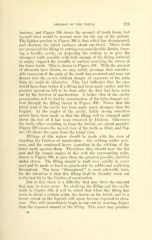Page 485 - My FlipBook
P. 485
ABKASION or THE TEETH. 221
incisors, and Figiu-e 306 shows the amount of tooth tissue lost
beyond what would be normal wear for the age of the patient.
The lighter portion in Figure 306 is that which has disappeared,
and shortens the labial surfaces about one-third. These teeth
are prepared for filling by cutting out considerable dentin, form-
ing a boxlike cavity, so disposing the cutting as to give the
strongest walls possible with bulk enough of the filling material
to amply support the breadth of surface receiving the stress of
the lower teeth. This is shown in Figure 307. With the amount
of abrasion here shown, we may safely presume that consider-
able recession of the pulp of the tooth has occurred and may cut
deeper into the crown without danger of exposure of the pulp
than we could do otherwise. This fact indicates that the case
would have done better if a filling had been made earlier and the
present operation left to be done after the first had been worn
out by the friction of mastication. A better idea of the cavity
preparation will be had by examination of the labio-lingual sec-
tion through the filling shown in Figure 309. Notice that the
labial wall of the cavity has been made much stronger than the
lingual. At the angles of the cavity, fairly strong retention
points have been made so that the filling will be retained until
about the last of it has been removed by friction. Otherwise
the walls, after rounding in from the ineisal, are about parallel.
Figure 308 shows the ineisal view of the teeth as filled, and Fig-
ure 310 shows the same from the labial view.
Fillings of this nature should be made with the view of
standing the friction of mastication — the rubbing under pres-
sure, and the continued heavy pounding in the striking of the
lower teeth against them. Therefore, they should have the flat
seat and the square angles of this with the surrounding walls,
shown in Figure 309, to give them the greatest possible stability
under stress. The filling should be built very solidly in every
part and be made as hard as practicable by additional malleting
throughout. The term "throughout" is used advisedly here,
for the intention is that this filling shall be literally worn out
to the last bit by the friction of mastication.
But in this there is a difficulty that may limit the amount
that may be woi'n away. By studying the filling and the cavity
walls in Figure 309, it will be noted that when this filling has
worn to about a certain point, the dentin on the labial, and to a
lesser extent on the lingual, will again become exposed to abra-
sion. This will immediately begin to cup oiit by wearing deei^er
than the exposed enamel or the filling. This wear may produce
32


